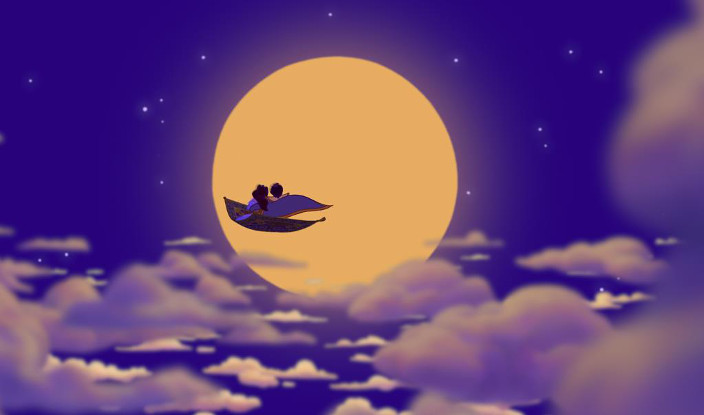
by Amina Khan
White-washing in Hollywood has been an issue for as long as it has existed, and Disney’s newest live-action adaption of “Aladdin” is no exception.
“Aladdin” was narrated by a Syrian and was not a part of the original “1001 Tales of Arabian Nights” (but added later on by a French translator). The beginning references China as Aladdin, a poor, young Chinese man, lived in a remote city with his mother. One day, an evil Maghreb sorcerer approaches him, claims to be his father’s brother, and tricks him into retrieving the oil lamp from the magic cave. You know how the story goes from there.
Disney’s Troubled History
Disney has faced backlash for the film “Aladdin” for its stereotypical representations of Arabs. It juxtaposes the idealistic, light-skinned, “beautiful” image of an Arab (note how light-skinned Naomi Scott, who plays Jasmine, is), with portrayals of darker Arabs with grotesque features and foreign accents as poor merchants.
Jack Shaheen, a writer on ethnic stereotypes, warns that the images portrayed in Disney perpetuate harmful stereotypes that “literally sustain adverse portraits across generations.” He argues, “There is a commanding link between make-believe aberrations and the real world,” and cautions of the negative portrayal of Agrabah, the film’s fictionalized city that he called “Hollywood’s fabricated Ayrabland.”
Shaheen had helped Disney alter lyrics in a song in “Aladdin” that was initially racist: from “Where they cut off your ear / If they don’t like your face,” which changed to “Where it’s flat and immense / And the heat is intense.”
Genie in the Bottle
The term “genie” was extracted from Arabic tales of the djinn and is an Islamic term. The djinn is a variety of spiritual beings, both good and evil, a cross between Angels and humankind. To capture djinn to become their slaves, the best Arabian magicians would tie them to lamps or rings. Djinn were never obligated to grant wishes to their captors; if they did, it would be out of gratitude. Some djinn would accept freedom, while others would kill the person that released them as a matter of revenge on humanity. Additionally, djinn would not be “living” in the lamp; they are there against their will.
Why does this controversy matter? It’s just a children’s story–right? Aren’t folktales always revised?
Inaccurate media representations of a culture silence the races and religious groups that seek an authentic light.
Sure, Naomi Scott may (kind of) look like Princess Jasmine (original name Badroulbadour meaning “full moon” in Arabic), but Scott is of British and South-Asian descent, not Middle-Eastern. This notion shows the harshness of comparing Indians to Middle-Easterners as parallel. It’s an ‘American’ analysis of executing the idea that two completely different cultures must be the same thing because of similar physical attributes.
Billy Magnussen has been cast as “Prince Anders,” in addition to two new characters brought into the play. The new white prince is said to be Aladdin’s rival as he, too, is aiming to win Princess Jasmine’s heart. Why must POC continuously have to compete with white people to prove their worth, both on-screen and off?
Although I don’t agree that adding one white character makes the entire live-action play “white-washed”, it should explain how Hollywood and Disney still fail to recognize that a story can exist with no Caucasian people in it.
The glaring problem lies in media normalizing the suppression of POC while benefiting from their “exotic culture.” To them, it’s ok to deprive the vibrant culture of a minority, forcing it to an ‘American’ or ‘European’ standard, and then refuse to grant ownership.
The Cast is Not the Major Problem of ‘Aladdin’
From Americanizing Jasmine and Aladdin’s voices, while implanting Arab accents on antagonists, to the dependency of women in Islam on men: “Aladdin” is hugely racist. It reinforces the Western perception of the Middle East as authoritarian and harsh.
Additionally, Arab words were mispronounced in the film as illogical scribbles took the place of actual Arabic writing. Even Aladdin was modeled after Tom Cruise, as stated by Peter Schnieder, the president of the feature animation at the time. Director Guy Ritchie could have seized this opportunity to improve the media representation of the Arab World, but it wouldn’t make much profit, would it?
Long-term Effects of Symbolic Annihilation and Vilification
There is proven psychology for people intensely affected by not seeing people like them in the media. Racial and gender exclusion affects a viewer’s own identity and self-conception. Whether it be race, religion, or even body size, images on-screen reflect an internal conflict, which triggers different coping mechanisms.
Proper representation sparks a cathartic release and instills confidence in the minds of POC. It’s empowering to see someone of your skin color in the media as something other than what society has labeled you.
Jafar epitomizes the stereotypical perception of Arab men. The villain is always aiming to inflict harm and portrays a patriarchal and threatening figure. And of course, Disney morphed Badroulbador to the sexualized and submissive Princess Jasmine.
Path Being Paved For Representation in the Media
Despite the stereotypical perceptions in “Aladdin,” the film still provides vital opportunities for Middle-Eastern people to fulfill a role other than a blood-thirsty terrorist, as the media loves to portray. Disney technically did cast a Middle-Eastern (Egyptian) Mena Massoud as Aladdin; however, they failed to choose the rest of the cast accordingly.
[Read Related: An Oscar Nomination For Dev Patel Isn’t Proof of South Asian Progress in Hollywood- But it’s a Start]
Although it’s a lengthy battle for POC, accurate and enlightening representation is slowly but effectively making its way into Hollywood. The first black man to win a directing Emmy (Donald Glover), the first black woman to win a comedy-writing Emmy (Lena Waithe), and the first South-Asian Muslim man to win an acting Emmy (Riz Ahmed) just made history.
As spoken by a hopeful Riz Ahmed, “I don’t know if any one person’s win of an award or one person snagging one role or one person doing very well changes something that’s a systemic issue of inclusion,” he said. “I think that’s something that happens slowly over time. If there’s enough isolated examples of success over time, then the dots start joining up, and it is not as slow a process as it sometimes is.”
 Amina Khan is a writer and painter living in Dallas, TX. You can see her work here.
Amina Khan is a writer and painter living in Dallas, TX. You can see her work here.




